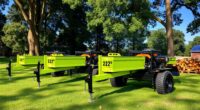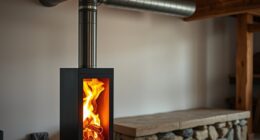The Ecodesign Directive requires you to choose wood stoves that meet strict environmental standards for emissions and efficiency. This means your new stove should produce less smoke and pollution while providing better heating performance. Manufacturers now incorporate advanced technology to guarantee cleaner combustion and conserve energy. By selecting compliant models, you help reduce environmental impact and enjoy more efficient heating. Keep exploring to understand how these standards can benefit your home and the environment.
Key Takeaways
- The Ecodesign Directive sets strict standards to reduce emissions and improve energy efficiency of wood stoves.
- New stoves must meet specific environmental requirements, including lower particulate and VOC emissions.
- Advanced combustion technology enhances efficiency, producing more heat with less fuel and cleaner smoke.
- Labels indicate compliance, helping consumers choose environmentally friendly and high-performing wood stoves.
- The directive promotes innovation, leading to cleaner, more efficient stoves that benefit air quality and sustainability.

If you own or are considering purchasing a wood stove, understanding the Ecodesign Directive is vital. This European regulation aims to make heating appliances more environmentally friendly by setting strict standards for emissions and efficiency. For you, this means that any new wood stove you buy must meet specific requirements that reduce pollution and improve performance. The directive emphasizes improving combustion efficiency, which directly impacts how effectively your stove burns wood. A higher combustion efficiency means more heat from less fuel, less smoke, and fewer harmful emissions. When a stove operates efficiently, it converts more of the wood’s energy into heat, reducing waste and lowering your fuel costs over time.
The Ecodesign Directive also establishes clear emission standards that your stove must meet. These standards limit the amount of pollutants, such as particulate matter and volatile organic compounds, released into the air during operation. By adhering to these standards, manufacturers design stoves that produce cleaner smoke and fewer emissions, helping to protect air quality and reduce your environmental footprint. When shopping for a stove, you’ll notice labels indicating compliance with these standards, giving you confidence that your purchase aligns with current environmental regulations.
Understanding these requirements can seem overwhelming at first, but it’s straightforward once you realize that they prioritize efficiency and low emissions. Modern wood stoves are equipped with advanced combustion technology that ensures more complete burning of the wood, which not only enhances combustion efficiency but also minimizes smoke and pollutants. This means you’ll enjoy a warmer, cleaner burn, and your stove will operate more effectively with less frequent cleaning or maintenance. If you’re replacing an old model, choosing one that complies with the Ecodesign Directive guarantees that you’re investing in a more sustainable and environmentally responsible appliance.
Modern stoves with advanced combustion technology burn cleaner and more efficiently, reducing maintenance and environmental impact.
Furthermore, the directive encourages ongoing innovation in stove design. Manufacturers are motivated to develop new features and technologies that meet or exceed these standards, leading to better performance and less impact on the environment. As a consumer, this means you’ll benefit from more efficient, cleaner-burning stoves on the market. Additionally, understanding whole‑home backup power standards can help you appreciate the broader benefits of environmentally responsible appliances beyond just heating. Ultimately, understanding the Ecodesign Directive helps you make informed decisions about your heating options, ensuring you select a stove that’s not only effective but also aligns with current environmental policies. By prioritizing models that meet these standards, you’re supporting cleaner air, reduced emissions, and a more sustainable way to heat your home.
Frequently Asked Questions
How Often Are Ecodesign Standards Updated for Wood Stoves?
You might be pleased to know that ecodesign standards for wood stoves are updated periodically, aligning with evolving regulatory changes. Typically, these updates happen every few years, ensuring environmental and efficiency improvements stay current. While there’s no fixed schedule, staying informed about the latest regulatory changes helps you keep your stove compliant and eco-friendly. Regular reviews and adjustments mean the standards remain relevant, supporting your commitment to sustainable living.
Are There Exemptions for Historic or Antique Wood Stoves?
You’ll find that historic exemptions and antique stove regulations often apply to vintage or antique wood stoves, allowing them to bypass some current Ecodesign standards. These exemptions recognize their cultural and historical value, but you should verify specific regulations in your region. Keep in mind that while these exemptions exist, modern safety and efficiency requirements still aim to reduce emissions, so consult local authorities for detailed guidance on antique stove regulations.
How Do Ecodesign Rules Affect Wood Stove Maintenance Practices?
Did you know that proper maintenance can cut emissions by up to 50%? The Ecodesign rules mean you need to follow specific maintenance routines and cleaning schedules to keep your wood stove compliant. You should regularly check for creosote buildup, clean the chimney, and inspect seals. Staying on top of these tasks guarantees your stove operates efficiently, reduces pollution, and helps you avoid potential fines or restrictions.
What Are the Penalties for Non-Compliance With Ecodesign Regulations?
If you don’t comply with ecodesign regulations, enforcement authorities can impose penalties like fines or product bans. Non-compliance leads to serious consequences, including legal actions and damage to your reputation. Penalties enforcement guarantees that manufacturers and sellers follow the rules, so you’re responsible for maintaining compliance. Stay aware of the consequences, and regularly check your products to avoid costly penalties and ensure you meet all ecodesign standards.
Can I Sell Imported Wood Stoves That Don’t Meet Ecodesign Standards?
Think of it like trying to bring a Trojan horse into your shop—you can’t sell imported wood stoves that don’t meet Ecodesign standards. You’ll face import restrictions and hefty import duties, making it risky and costly. To stay compliant, verify your imports meet the required eco-friendly criteria. Ignoring these rules risks fines, product seizure, or even banning your sales altogether, so it’s best to play by the rules from the start.
Conclusion
By embracing the Ecodesign Directive, you not only reduce your environmental impact but also enjoy cleaner, more efficient heating. It’s a reminder that small choices, like selecting a compliant wood stove, can make a big difference. Just as a cozy fire warms your home, responsible design warms the planet. So, while your stove keeps you comfortable, it also plays a crucial role in protecting the environment for future generations.











